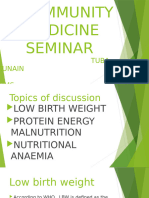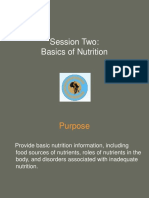Group 2mini Task
Uploaded by
thrillesayumiGroup 2mini Task
Uploaded by
thrillesayumiIntroduction:
Nutrien deficiency in the Philippines
protein-energy malnutri- tion (PEM), Vitamin A
Deficiency (VAD), Iron Deficiency Anae- mia (IDA) and
Iodine Deficiency Disorder (IDD).
Potein Disease/s Prevalence Most Affected Recommendati
Rate Age group on for
Prevention/s
Energy Kwashiorkor 42.9, 29.1, 19.4, below five years the intake of
malnutrition (malnutrition ) and 4.9% of age protein,
marasmus carbohydrates,
(severe water, minerals
undernourished and vitamins
ment) need to be
gradually
increased
Vitamin A whooping cough 15.5% by 2019. young children Eating simple,
and tuberculosis and pregnant wholesome food
women in such as
low-income groundnut,
countries soybean, pulses,
etc.
Iron Anemia often known as aged 6-11 Eating foods
IDA months high in iron,
infants (40.5%), eating food with
pregnant women high vitamin C.
(26.4%),
lactating women
(16.7%), and
elderly males
(23.0%)
Calcium hyperparathyroid 97.2% of adults females older increasing
ism and Paget's and 95.5% of than 4 years, dietary intake of
disease of bone elderly suffer and especially calcium-rich
from calcium adolescent foods, taking
deficiency. females, and calcium and
males aged vitamin D
9–18 years or supplements,
older than 51 and making
years lifestyle changes
such as regular
weight-bearing
Zinc acrodermatitis 30.0% 50 and above. eat foods that
enteropathica, are high in zinc
cheilitis, and especially dairy
dermatitis. foods, poultry,
meat and
seafood.
Vitamin D Tuberculosis 48.7% 25-55 year old TB preventive
treatment, take
all TB medicine
exactly as
prescribed.
Summary of findings:
1. Nutrient Deficiency: Is a significant public health concern in the Philippines, with iron
deficiency anemia being the most prevalent. Vitamin A deficiency is also widespread,
particularly among children, impacting their vision and immune system. Calcium
deficiency affects women and older adults, increasing their risk of osteoporosis and
fractures. Zinc deficiency is prevalent, impacting growth, immunity, and cognitive
development. While protein deficiency is less common, it can still affect vulnerable
groups, particularly children in low-income households.
2. Nutrient deficiencies: have a profound impact on health, leading to impaired growth
and development, weakened immune systems, and increased susceptibility to infections.
These deficiencies can also contribute to chronic diseases, reduced productivity, and
increased healthcare costs. Addressing nutrient deficiencies is crucial for improving
overall health and well-being, particularly among vulnerable populations.
3. Preventing nutrient: deficiencies involves promoting dietary diversification, encouraging
the consumption of nutrient-rich foods, and implementing fortification programs to add
essential nutrients to staple foods. Treatment typically involves addressing the
underlying cause of the deficiency, such as improving dietary intake or providing
supplements. In some cases, medical interventions may be necessary to address
complications arising from severe deficiencies.
Reference/s: https://www.tbalert.org/about-tb/what-is-tb/prevention/
Prepared by: Mary Ayumi Ofelia P trilles & Mary France otic (group 2—8-Simplicity)
You might also like
- CPG On Maternal Nutrition and Supplementation 2013No ratings yetCPG On Maternal Nutrition and Supplementation 201333 pages
- ECE 380: Control Systems: Winter 2011 Course Notes, Part I Section 002No ratings yetECE 380: Control Systems: Winter 2011 Course Notes, Part I Section 00295 pages
- Unit - I Introduction: Subjects Notes BSC Nursing Part - I Subject: Nutrition100% (3)Unit - I Introduction: Subjects Notes BSC Nursing Part - I Subject: Nutrition14 pages
- Module 4 Maternal and Child Care NutritionNo ratings yetModule 4 Maternal and Child Care Nutrition27 pages
- Oliver Strange - Sudden Westerns 06 - Sudden Gold-Seeker (1937)100% (2)Oliver Strange - Sudden Westerns 06 - Sudden Gold-Seeker (1937)110 pages
- Nutritional Problems in Public Health_watermarkNo ratings yetNutritional Problems in Public Health_watermark14 pages
- CHAP-3 Notes For Public Health and Nutrition0% (1)CHAP-3 Notes For Public Health and Nutrition9 pages
- Indian Health&Wellness Report 20241202 221310 0000No ratings yetIndian Health&Wellness Report 20241202 221310 000021 pages
- Unit-7: National Nutritional Unit-8: National Strategic andNo ratings yetUnit-7: National Nutritional Unit-8: National Strategic and60 pages
- Nutritional problems in Nepal (practical)2024-2No ratings yetNutritional problems in Nepal (practical)2024-222 pages
- Nutritional Problems in India & World: Ways To Combat: DR Kalpana KulshresthaNo ratings yetNutritional Problems in India & World: Ways To Combat: DR Kalpana Kulshrestha39 pages
- NCM105_ GLOBAL EFFORTS TO ADDRESS NUTRITION.docxNo ratings yetNCM105_ GLOBAL EFFORTS TO ADDRESS NUTRITION.docx5 pages
- Tlisk - Ci-Viii-D - RND - Group-D - Nutrition Problems and Programs in IndiaNo ratings yetTlisk - Ci-Viii-D - RND - Group-D - Nutrition Problems and Programs in India8 pages
- [Ebooks PDF] download (Ebook) Combating Micronutrient Deficiencies: Food-Based Approaches by Brian Thompson, Leslie Amoroso ISBN 9781845937140, 1845937147, 9251065462 full chapters100% (3)[Ebooks PDF] download (Ebook) Combating Micronutrient Deficiencies: Food-Based Approaches by Brian Thompson, Leslie Amoroso ISBN 9781845937140, 1845937147, 9251065462 full chapters81 pages
- Blasbalg Et Al 2011 Econutrition and Utilization of Food Based Approaches For Nutritional HealthNo ratings yetBlasbalg Et Al 2011 Econutrition and Utilization of Food Based Approaches For Nutritional Health10 pages
- Micheline Beaudry, Ph.D. Université LavalNo ratings yetMicheline Beaudry, Ph.D. Université Laval20 pages
- Food Science Nutrition - 2019 - Chadare - Conventional and Food To Food Fortification An Appraisal of Past Practices andNo ratings yetFood Science Nutrition - 2019 - Chadare - Conventional and Food To Food Fortification An Appraisal of Past Practices and15 pages
- Food Fortification in India Enriching Food Lives - Ms Deepti GulatiNo ratings yetFood Fortification in India Enriching Food Lives - Ms Deepti Gulati35 pages
- Community Nutrition Nestle Nutrition InstituteNo ratings yetCommunity Nutrition Nestle Nutrition Institute4 pages
- Community Nutrition: Prepared By:Mrs Bemina J A Assistant Professor ESIC College of Nursing Kalaburagi100% (1)Community Nutrition: Prepared By:Mrs Bemina J A Assistant Professor ESIC College of Nursing Kalaburagi52 pages
- Nutrition Global Health: Micheline Beaudry, Ph.D. Université LavalNo ratings yetNutrition Global Health: Micheline Beaudry, Ph.D. Université Laval20 pages
- Nutrition Intervention: Kiday H. (Msc/Nutrition)No ratings yetNutrition Intervention: Kiday H. (Msc/Nutrition)42 pages
- Micro-Nutrient Interventions: (And Parts of Module 4)No ratings yetMicro-Nutrient Interventions: (And Parts of Module 4)31 pages
- Palayakkarar Rebellion 12th History Lesson 9 Questions in English Old BookNo ratings yetPalayakkarar Rebellion 12th History Lesson 9 Questions in English Old Book9 pages
- Gravity Feeding Drip Rate Chart: Home Care ServicesNo ratings yetGravity Feeding Drip Rate Chart: Home Care Services2 pages
- Guidance and Councelling For Rehabilitation100% (4)Guidance and Councelling For Rehabilitation10 pages
- International Standard: Oscillation-Type Density Meters0% (1)International Standard: Oscillation-Type Density Meters8 pages
- Leadin G: Group 6 Concon, Alyssa Anne P. Al-Ghazali, Ahmed Qasem Omar Melbert MabingnayNo ratings yetLeadin G: Group 6 Concon, Alyssa Anne P. Al-Ghazali, Ahmed Qasem Omar Melbert Mabingnay31 pages
- 1.1.8. MLCP Technical Specification - SAG - New - E-House - 3BHS353481 - RevNo ratings yet1.1.8. MLCP Technical Specification - SAG - New - E-House - 3BHS353481 - Rev11 pages
- BS EN 474-9-2006+A1-2009 Earth-Moving Machinery - Safety - P PDFNo ratings yetBS EN 474-9-2006+A1-2009 Earth-Moving Machinery - Safety - P PDF20 pages
- Random, Metamorphic Epistemologies For DHCP: BstractNo ratings yetRandom, Metamorphic Epistemologies For DHCP: Bstract3 pages

























































































